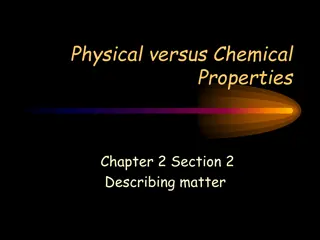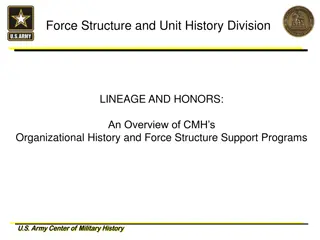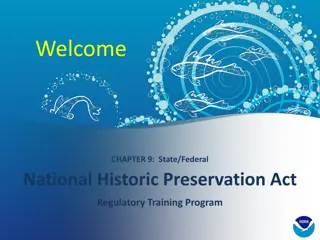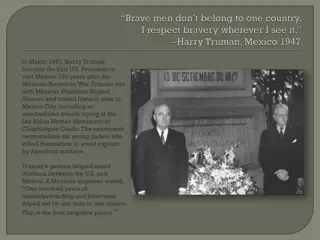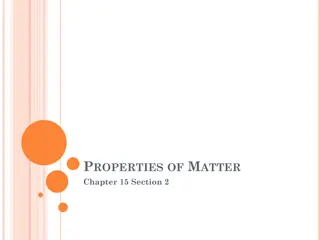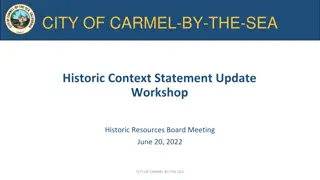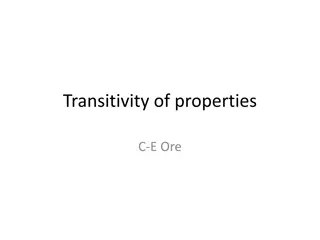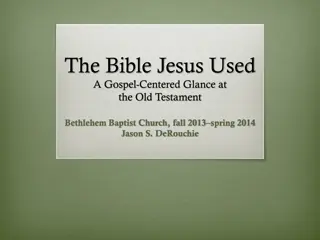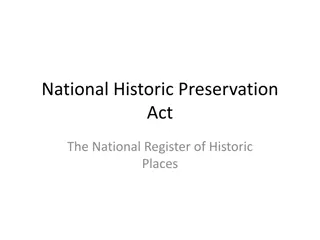The Difference Between Old and Historic Properties
Exploring the distinction between old and historic properties, this content delves into the criteria that determine a building's historical significance, emphasizing the importance of age, physical integrity, and historical significance. It highlights the impact of these distinctions on property preservation, protection, and cultural significance, shedding light on why historic buildings are deemed worthy of conservation efforts.
Download Presentation

Please find below an Image/Link to download the presentation.
The content on the website is provided AS IS for your information and personal use only. It may not be sold, licensed, or shared on other websites without obtaining consent from the author.If you encounter any issues during the download, it is possible that the publisher has removed the file from their server.
You are allowed to download the files provided on this website for personal or commercial use, subject to the condition that they are used lawfully. All files are the property of their respective owners.
The content on the website is provided AS IS for your information and personal use only. It may not be sold, licensed, or shared on other websites without obtaining consent from the author.
E N D
Presentation Transcript
Old v/s Historic What is historic anyway? Melissa Wyllie @Historic_Nash @mswyllie #oldhousefair
Why does it matter? Impacts whether a property is worth saving Impacts how that property may be protected Impacts construction/renovation for a property or community Affects the culture of a place, whether locally, regionally or nationally Old buildings are just old while historic buildings are worthy of preservation. @Historic_Nash @mswyllie #oldhousefair
What is Historic? To be considered historic, a property must have three essential attributes: Sufficient age (generally at least 50 years old). That means buildings built in 1964 or earlier historic. A relatively high degree of physical integrity Historical significance. That last one s where it gets tricky @Historic_Nash @mswyllie #oldhousefair
Historic Criteria #1: Age Generally for a property to be old enough to be historic it must be at least 50 years old, although this is just a general rule of thumb. The property must be old enough to have been studied by historians, architectural historians, or archaeologists so its place in history is clear. @Historic_Nash @mswyllie #oldhousefair
Criteria #2: Integrity A property must retain its historic physical integrity. This means the property must be relatively unchanged. Its essential character-defining features relative to its significance must still be present. In my neighborhood some folks want every old building saved even though they are infested with termites, full of asbestos and other general neglect issues. @Historic_Nash @mswyllie #oldhousefair
Criteria #3: Significance A property must be considered significant to be historic. When most people think 'historically significant,' they may be thinking of history class-type history, rather than architectural history. (1) Association with individuals, events, activities, or developments that shaped, or reflect important aspects of our history (2) Characteristics of an architectural style or type of building, or a method of construction. Embodying high artistic values or fine craftsmanship (3) Potential to yield information important to our understanding of the past through archaeological, architectural, or other physical investigation and analysis. @Historic_Nash @mswyllie #oldhousefair
For Example: Constructed from 1952-1954 Good example of post- World War II modern design One of the best examples of mid- century modern office architecture in the state Eligible for listing in the National Register of Historic Places Named after a significant American Statesman, Tennessean Cordell Hull, the longest serving secretary of state The Cordell Hull Building @Historic_Nash @mswyllie #oldhousefair
For Example: East Nashville Free House c.1885 Queen Anne- style house Sits on Eastland Avenue in East Nashville Originally the Spout Spring School In the 1970s, it was converted into 3 apartments. The house is not located within a historic overlay @Historic_Nash @mswyllie #oldhousefair
Where to Start? Gather information about the property description and documents Put the place in the context of history what can it tell us of a time in the past? An architectural style? The beliefs of a group of people? How well does it retain its character/architectural style The National Register of Historic Places "Criteria for Evaluation" or the designation standards found in a local historic preservation ordinance are commonly used to measure the significance of a historic property. Ten ways to look up your house s history. @Historic_Nash @mswyllie #oldhousefair
Nashvilles Historic Neighborhoods In Davidson County, there are over 4065 buildings or structures listed in the National Register individually or as a part of a National Register Historic District. Nashville's neighborhoods listed in the National Register of Historic Places are: Belle Meade Links Triangle, Belmont- Hillsboro, Buena Vista, East Nashville (including portions of Lockeland Springs and East End), Edgefield, Germantown, Hillsboro-West End, Old Hickory Village, Richland-West End, Waverly Place, Whites Creek and Woodland in Waverly. @Historic_Nash @mswyllie #oldhousefair
Nashvilles Historic Neighborhoods * Historic Preservation Zoning Overlay or a Neighborhood Conservation Zoning Overlay Belle Meade Links Triangle Belmont-Hillsboro Blakemore Broadway Cherokee Park Eastwood Edgefield Elmington Place Germantown Greenwood Hillsboro-West End Lockeland Springs-East End Maxwell Heights Park and Elkins Richland-West End See if your house is in an overlay @Historic_Nash @mswyllie #oldhousefair
For Additional Information: Historic Nashville, Inc. www.historicnashvilleinc.org Metropolitan Nashville Historical Commission www.nashville.gov/Historical-Commission.aspx Tennessee Historical Commission www.tn.gov/environment/history/ National Preservation Trust www.preservationnation.org Secretary of the Interior s Treatment of Historic Properties Standards www.nps.gov/tps/standards.htm @Historic_Nash @mswyllie #oldhousefair
Thank You Keep Nashville Unique. www.historicnashvilleinc.org @Historic_Nash @mswyllie #oldhousefair
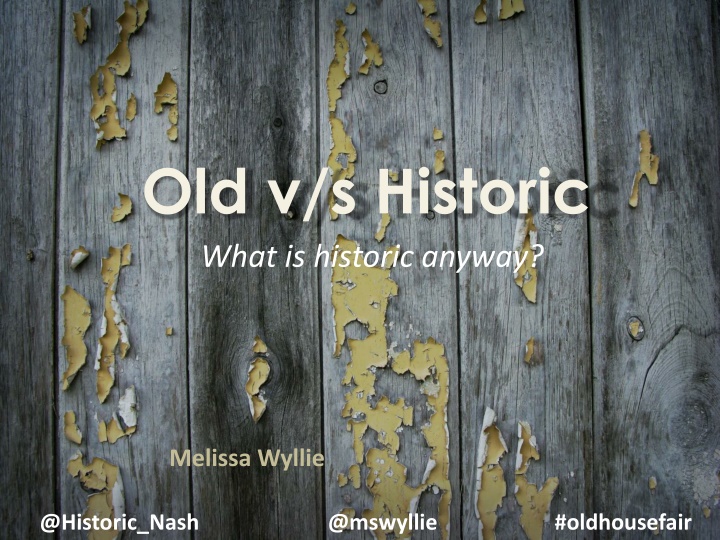


![❤[PDF]⚡ Apollo Mission Control: The Making of a National Historic Landmark (Spr](/thumb/21551/pdf-apollo-mission-control-the-making-of-a-national-historic-landmark-spr.jpg)



